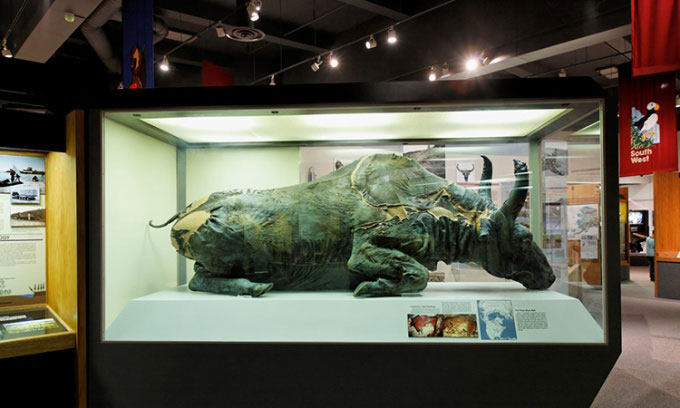Strange dinner with stew made from 50,000-year-old bison mummified meat
In 1984, scientists enjoyed a strange dinner of stew made from the meat of steppe bison frozen tens of thousands of years ago .
In 1979, gold miners discovered an exceptionally well-preserved bison ( Bison priscus ) mummified in the Alaskan tundra and turned it over to scientists. The rare specimen was then named Blue Babe and is the only example of a bison from the Pleistocene to be excavated from the permafrost. Tooth and claw marks suggest that Blue Babe was most likely killed by the lion's ancestor, the North American lion ( Panthera leoatrox ).

Blue Babe bison on display at the University of Alaska Museum of the North. (Photo: Patricia Fisher)
Initial collagen analysis suggested that Blue Babe lived around 36,000 years ago, but more modern studies have revised this figure to 50,000 years. The rapid transformation into a block of ice after death resulted in exceptionally well-preserved muscle tissue, comparable to that of beef jerky, plus fat and bone marrow.
The researchers then decided to try using a portion of this special specimen— neck meat —to make beef stew. This was not unprecedented. They had heard that Russian scientists had unearthed animals like bison and mammoths frozen in the Far North that were so well preserved that they could be eaten, editor Rachael Funnel wrote on IFL Science on October 14.
"To celebrate and commemorate Eirik Granqvist's (conservationist and taxidermist) work with Blue Babe, we had a bison stew dinner for him and for Bjorn Kurten, who gave a presentation. A small piece of the bison's neck was sliced off and simmered in a pot with vegetables and other ingredients," Dale Guthrie, who played a key role in excavating Blue Babe, wrote about the event.
The unusual dinner took place at Guthrie's home in Alaska. "We had Blue Babe for dinner. The meat was well done but still a little chewy, which gave the stew a rich Pleistocene aroma. No one there would have missed it ," Guthrie said.
"Doing a neck steak didn't seem like a good idea. But you know, we could put a lot of vegetables and spices in it, and it wouldn't be too bad," he explained of why they chose stew.
"When it thawed, it gave off an unmistakable beefy smell, mixed with a slight earthy smell around it, with a hint of mushroom. A dozen or so of us gathered on April 6, 1984, to enjoy a bison stew ," Guthrie said. He also said that the stew tasted delicious and no one suffered any ill effects from the meal.
- What do archaeologists do when they discover a 36,000-year-old wild cow mummy?
- 4 mistakes when eating dinner cause great harm to your health, maybe you also have it
- Reviving the 1.500kg extinct bison, 400 years old
- The assertive cave picture on Earth once existed in the hybrid bison
- Horrified driver encounters 150 bison spilling onto the road
- How harmful it is to have dinner late
- Cranial mountain exposed the great massacre of bison
- Bison cows re-export in the US National Park
- From the bison, learn more about the first person to set foot in America
- 10 mistakes everyone makes when cooking meat
- German police shot rare cows 250 years a time
- Making meat from ... air
 Discovered an ancient centipede fossil 99 million years old
Discovered an ancient centipede fossil 99 million years old Discovered bat-like dinosaurs in China
Discovered bat-like dinosaurs in China Discovered a 200-year-old bronze cannon of the coast
Discovered a 200-year-old bronze cannon of the coast Discover 305 million-year-old spider fossils
Discover 305 million-year-old spider fossils